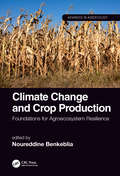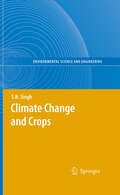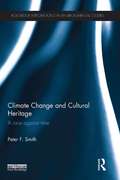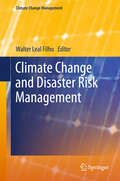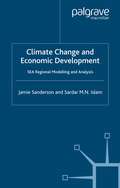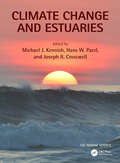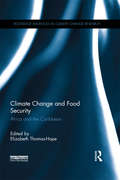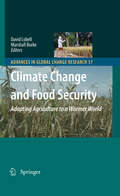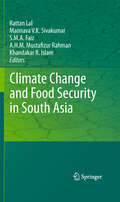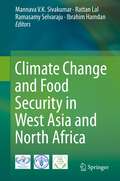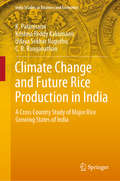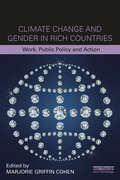- Table View
- List View
Climate Change and Cotton Production in Modern Farming Systems (ICAC Reviews)
by Michael P Bange J. Baker P. Bauer K. J. Broughton G. Constable Q. Luo D. M. Oosterhuis Y. Osanai P. Payton D. T. Tissue K Reddy B. K. SinghThroughout the world cotton is broadly adapted to growing in temperate, sub-tropical, and tropical environments, but growth may be challenged by future climate change. Production may be directly affected by changes in crop photosynthesis and water use due to rising CO2 and changes in regional temperature patterns. Indirect effects may result from a range of government regulations aimed at climate change mitigation. While there is certainty that future climate change will impact cotton production systems; there will be opportunities to adapt. This review begins to provide details for the formation of robust frameworks to evaluate the impact of projected climatic changes, highlight the risks and opportunities with adaptation, and details the approaches for investment in research. Ultimately, it is a multi-faceted systems-based approach that combines all elements of the cropping system that will provide the best insurance to harness the change that is occurring, and best allow cotton industries worldwide to adapt. Given that there will be no single solution for all of the challenges raised by climate change and variability, the best adaptation strategy for industry will be to develop more resilient systems. Early implementation of adaptation strategies, particularly in regard to enhancing resilience, has the potential to significantly reduce the negative impacts of climate change now and in the future.
Climate Change and Crop Production: Foundations for Agroecosystem Resilience (Advances in Agroecology)
by Noureddine BenkebliaPresenting an overview of agroecology within the framework of climate change, this book looks at the impact of our changing climate on crop production and agroecosystems, reporting on how plants will cope with these changes, and how we can mitigate these negative impacts to ensure food production for the growing population. It explores the ways that farmers can confront the challenges of climate change, with contributed chapters from around the world demonstrating the different challenges associated with differing climates. Examples are provided of the approaches being taken right now to expand the ecological, physiological, morphological, and productive potential of a range of crop types. Describes the effects and responses of the macro and micro levels of crops under the different components of climate change Reports on the adaptation and resilience of food production systems within the changing climate Covers how plants cope with the changing climate including physiological, biochemical, phenotype, and ecosystem responses Provides an in-depth discussion on the importance of agricultural education connected to climate change Giving readers a greater understanding of the mechanisms of plant resilience to climate change, this book provides new insights into improving the productivity of an individual crop species as well as bringing resistance and resiliency to the entire agroecosystem. It offers a strong foundation for changing research and education programs so that they build the resistance and resilience that will be needed for the uncertain climate future ahead.
Climate Change and Crop Production: Foundations for Agroecosystem Resilience (Advances in Agroecology)
by Noureddine BenkebliaPresenting an overview of agroecology within the framework of climate change, this book looks at the impact of our changing climate on crop production and agroecosystems, reporting on how plants will cope with these changes, and how we can mitigate these negative impacts to ensure food production for the growing population. It explores the ways that farmers can confront the challenges of climate change, with contributed chapters from around the world demonstrating the different challenges associated with differing climates. Examples are provided of the approaches being taken right now to expand the ecological, physiological, morphological, and productive potential of a range of crop types. Describes the effects and responses of the macro and micro levels of crops under the different components of climate change Reports on the adaptation and resilience of food production systems within the changing climate Covers how plants cope with the changing climate including physiological, biochemical, phenotype, and ecosystem responses Provides an in-depth discussion on the importance of agricultural education connected to climate change Giving readers a greater understanding of the mechanisms of plant resilience to climate change, this book provides new insights into improving the productivity of an individual crop species as well as bringing resistance and resiliency to the entire agroecosystem. It offers a strong foundation for changing research and education programs so that they build the resistance and resilience that will be needed for the uncertain climate future ahead.
Climate Change and Crops (Environmental Science and Engineering)
by S. N. SinghClimate change is directly linked to the human activities, according to the Fourth Assessment Report of IPCC (2007). In last two decades of 20th Century, accelerated anthropogenic activities pushed up the atmospheric abundance of greenhouse gases, mainly CO2, CH4, and N2O, alarmingly which enhanced the radiative forcing of the Earth’s surface and thus perturbed its heat radiation balance. As a consequence, atmospheric characteristics, such as temperature, rainfall pattern, levels of CO2 and O3 have changed significantly, affecting the farm productivity. Although rising level of CO2 may have fertilizing effect on C3 crops, but concomitant rise in atmospheric temperature, O3 level and extreme weather conditions can not only nullify the fertilizing effect of CO2, but also drastically reduce the crop production, threatening food security to burgeoning world population. Agricultural crops are not only victim of climate variability and extreme whether conditions, but also serve as a potential source of CH4 and N2O. Therefore, in changed scenario, Kyoto Protocol (1997) has sought all signatory developed nations to cut down their emission levels as per their differential commitments to UNFCCC and developing nations to invest in less carbon emission projects to avert the process of global warming process. In this context, the present edition, which compiles latest findings of studies carried out by the scientists on climate change and crops around the world, serves as a ready reckoner to crop scientists, atmospheric scientists, ecologists, environmentalists, research scholars and post- graduate students to update their knowledge and understanding on this issue.
Climate Change and Cultural Heritage: A Race against Time (Routledge Explorations in Environmental Studies)
by Peter F. SmithHistory reveals how civilisations can be decimated by changes in climate. More recently modern methods of warfare have exposed the vulnerability of the artefacts of civilisation. Bringing together a range of subjects - from science, energy and sustainability to aesthetics theory and civilization theory - this book uniquely deals with climate change and the ensuing catastrophes in relation to cultural factors, urbanism and architecture. It links the evolution of civilisation, with special emphasis on the dynamics of beauty as displayed in architecture and urbanism, to climate change. It then considers both the historic and predicted impacts of climate change and the threat it poses to the continued viability of human civilisation when survival is the top priority. This book gives students, researchers and professionals in architecture and sustainable design as well as anyone interested in the threat of global warming to civilisation, new insights as to what could be lost if action is not taken at a global level.
Climate Change and Cultural Heritage: A Race against Time (Routledge Explorations in Environmental Studies)
by Peter F. SmithHistory reveals how civilisations can be decimated by changes in climate. More recently modern methods of warfare have exposed the vulnerability of the artefacts of civilisation. Bringing together a range of subjects - from science, energy and sustainability to aesthetics theory and civilization theory - this book uniquely deals with climate change and the ensuing catastrophes in relation to cultural factors, urbanism and architecture. It links the evolution of civilisation, with special emphasis on the dynamics of beauty as displayed in architecture and urbanism, to climate change. It then considers both the historic and predicted impacts of climate change and the threat it poses to the continued viability of human civilisation when survival is the top priority. This book gives students, researchers and professionals in architecture and sustainable design as well as anyone interested in the threat of global warming to civilisation, new insights as to what could be lost if action is not taken at a global level.
Climate Change and Developing Countries (Advances in Global Change Research #11)
by Nijavalli H. Ravindranath Jayant A. SathayeAmong global environmental issues, climate change has received the largest attention of national and global policy makers, researchers, industry, multilateral banks and NGOs. Climate change is one of the most important global environmental problems with unique characteristics. It is global, long-term (up to several centuries) and involves complex interactions between climatic, environmental, economic, political, institutional and technological pressures. It is of great significance to developing countries as all the available knowledge suggests that they, and particularly their poorer inhabitants, are highly vulnerable to climate impacts. The projected warming of 1. 4 to 5. 8° C by 2100 and the related changes in rainfall pattern, rise in sea-level and increased frequency of extreme events (such as drought, hurricanes and storms) are likely to threaten food security, increase fresh water scarcity, lead to decline in biodiversity, increase occurrence of vector-borne diseases, cause flooding of coastal settlements, etc. Recognizing the potential threat of severe disruptions, the United Nations Conference on Environment and Development was organized in 1992 in Rio de Janeiro, Brazil to begin to address ways to reduce these impacts, which led to the formulation of the UN Framework Convention on Climate Change. This Convention and the subsequent Kyoto Protocol recognize “the common but differentiated responsibility” of developing and industrialized countries in addressing climate change. Developing countries thus have a unique role to play in formulating a sound, reasoned, and well informed response to the threat of climate change.
Climate Change and Development
by Thomas Tanner Leo Horn-PhathanothaiThe evidence for human-induced climate change is now overwhelming, the brunt of its impacts is already being felt by poor people, and the case for urgent action is compelling. This book addresses the two greatest challenges of our time – averting catastrophic climate change and eradicating poverty – and the close interconnections between them. Climate Change and Development provides a comprehensive and multi-disciplinary foundation for understanding the complex and tangled relationship between development and climate change. It argues that transformational approaches are required in order to reconcile poverty reduction and climate protection and secure sustained prosperity in the twenty first century. Section One provides the building blocks for understanding climate science and the nexus between climate and development. Section Two outlines responses to climate change from the perspective of developing countries, with chapters on international agreements, climate change mitigation and adaptation, and climate finance. Each chapter offers analytical tools for evaluating responses, enabling readers to ask smart questions about the climate change and development nexus as policy and action evolve in the coming years. The last three chapters of the book, contained in Section Three, are forward looking and focus on why and how development must be re-framed to deliver more equitable and sustainable outcomes. This section sets out different critiques of ‘development-as-usual’ and explores alternative paradigms of development in a warming and resource-constrained world. This is an invaluable and clearly written text that uses real world examples to bring to life perspectives from across different disciplines. It also contains chapter learning outcomes, and end of chapter summaries, discussion questions, and suggestions for further reading and relevant websites. The text is suitable for both undergraduate and postgraduate students, as well as those working in international development contexts who wish to get to grips with this pressing global challenge.
Climate Change and Development
by Thomas Tanner Leo Horn-PhathanothaiThe evidence for human-induced climate change is now overwhelming, the brunt of its impacts is already being felt by poor people, and the case for urgent action is compelling. This book addresses the two greatest challenges of our time – averting catastrophic climate change and eradicating poverty – and the close interconnections between them. Climate Change and Development provides a comprehensive and multi-disciplinary foundation for understanding the complex and tangled relationship between development and climate change. It argues that transformational approaches are required in order to reconcile poverty reduction and climate protection and secure sustained prosperity in the twenty first century. Section One provides the building blocks for understanding climate science and the nexus between climate and development. Section Two outlines responses to climate change from the perspective of developing countries, with chapters on international agreements, climate change mitigation and adaptation, and climate finance. Each chapter offers analytical tools for evaluating responses, enabling readers to ask smart questions about the climate change and development nexus as policy and action evolve in the coming years. The last three chapters of the book, contained in Section Three, are forward looking and focus on why and how development must be re-framed to deliver more equitable and sustainable outcomes. This section sets out different critiques of ‘development-as-usual’ and explores alternative paradigms of development in a warming and resource-constrained world. This is an invaluable and clearly written text that uses real world examples to bring to life perspectives from across different disciplines. It also contains chapter learning outcomes, and end of chapter summaries, discussion questions, and suggestions for further reading and relevant websites. The text is suitable for both undergraduate and postgraduate students, as well as those working in international development contexts who wish to get to grips with this pressing global challenge.
Climate Change and Disaster Risk Management (Climate Change Management)
by Walter Leal FilhoThere has been some degree of reluctance in the past to consider disaster risk management within the mainstream of adaptation to climate variability and climate change. However, there is now wide recognition of the need to incorporate disaster risk management concerns in dealing with such phenomena. There is also a growing awareness of the necessity for a multi-sectoral approach in managing the effects of climate variability and climate change, since this can lead to a significant reduction of risk. This book presents the latest findings from scientific research on climate variation, climate change and their links with disaster risk management. It showcases projects and other initiatives in this field that are being undertaken in both industrialised and developing countries, by universities and scientific institutions, government bodies, national and international agencies, NGOs and other stakeholders. Finally, it discusses current and future challenges, identifying opportunities and highlighting the still unrealised potential for promoting better understanding of the connections between climate variation, climate change and disaster risk management worldwide.
Climate Change and Economic Development: SEA Regional Modelling and Analysis
by J. Sanderson S. IslamFocusing on S.E. Asia, the economics of climate change and the relationship between climate change and economic development, this book examines the region's vulnerability to the impact of climate change, forecasts environmental and economic outcomes and opportunities these factors provide for policy actions towards alleviating this vulnerability.
Climate Change and Environmental Impacts: Past, Present and Future Perspective (Society of Earth Scientists Series)
by Binita Phartiyal Rahul Mohan Supriyo Chakraborty Venkatesh Dutta Anil Kumar GuptaEarth’s climate varies even without human influence but the acceleration in the changing pattern with cause and effect by/to the civilisation is a matter of concern to scientists. These patterns are lessons to understand future trends and ways and means for mitigation. The extreme weather events in almost every region of the globe involving excessive loss of human life and property are causing anxiety in society and posing challenges before scientists and planners. Cyclical variations in the Earth’s climate occur at multiple time scales, from years to decades, centuries, and millennia. Cycles at each scale are caused by a variety of physical mechanisms. In the last 65 Ma only, there have been several cycles of glacial advances and retreat, with the abrupt end of the last ice age about 11,700 years ago marking the beginning of the modern climate era and human civilization. A multidisciplinary approach in studying the Earth’s changing climate will provide a holistic view and guide us in future planning and programming.
Climate Change and Environmental Sustainability (Advances in Science, Technology & Innovation)
by Bao-Jie He Deo Prasad Gloria Pignatta Joni JupestaThis book discusses the challenges related to climate change mitigation and adaptation. It adds valuable strategies and insights into the development of new practices solving the identified social and economic problems related to ecosystem deterioration and anticipating other disasters related to climate change. As the decarbonization of cities and communities became an issue of great interest to many researchers, the book in hands will be of great importance to decision-makers and energy stakeholders and others seeking a more resilient and sustainable future and developing innovative technologies to overcome environmental deterioration.This book is a culmination of selected research papers from the first version of the international conference on ‘Climate Chance and Environmental Sustainability’ which was held in 2021 in collaboration with Chongqing University, China.
Climate Change and Estuaries (CRC Marine Science)
by Michael J. Kennish, Hans W. Paerl, and Joseph R. CrosswellClimate change is having an increasing impact on coastal, estuarine, and marine environments worldwide. This book provides state-of-the-art coverage of climate change effects on estuarine ecosystems from local, regional, and global perspectives. With editors among the most noted international scholars in coastal ecology and estuarine science and contributors who are world-class in their fields, the chapters in this volume consist of comprehensive studies in coastal, estuarine and marine sciences, climate change, and coastal management and provide an extensive international collection of data in tabular, illustrated, and narrative formats useful for coastal scientists, planners, and managers. Comprised of three sections: (1) physical-chemical aspects; (2) biological aspects; and (3) management aspects, the book not only examines climatic and non-climatic drivers of change affecting coastal, estuarine, and marine environments but also their interactions and effects on populations of organisms, communities, habitats, and ecosystem structure and function. Pulling together today’s most salient issues and key literature advances for those concerned with coastal management, it allows the reader to see across direct and indirect interactions among disciplinary and ecosystem boundaries. Climate Change and Estuaries meets the research needs of climate scientists, estuarine and marine biologists, marine chemists, marine geologists, hydrologists, and coastal engineers, while students, professors, administrators, and other professionals will also find it an exhaustive reference.
Climate Change and Estuaries (CRC Marine Science)
Climate change is having an increasing impact on coastal, estuarine, and marine environments worldwide. This book provides state-of-the-art coverage of climate change effects on estuarine ecosystems from local, regional, and global perspectives. With editors among the most noted international scholars in coastal ecology and estuarine science and contributors who are world-class in their fields, the chapters in this volume consist of comprehensive studies in coastal, estuarine and marine sciences, climate change, and coastal management and provide an extensive international collection of data in tabular, illustrated, and narrative formats useful for coastal scientists, planners, and managers. Comprised of three sections: (1) physical-chemical aspects; (2) biological aspects; and (3) management aspects, the book not only examines climatic and non-climatic drivers of change affecting coastal, estuarine, and marine environments but also their interactions and effects on populations of organisms, communities, habitats, and ecosystem structure and function. Pulling together today’s most salient issues and key literature advances for those concerned with coastal management, it allows the reader to see across direct and indirect interactions among disciplinary and ecosystem boundaries. Climate Change and Estuaries meets the research needs of climate scientists, estuarine and marine biologists, marine chemists, marine geologists, hydrologists, and coastal engineers, while students, professors, administrators, and other professionals will also find it an exhaustive reference.
Climate Change and Eye Disease: Eye Health and Blindness in a Hostile Environment (Routledge Studies in Environment and Health)
by Scott FraserThis book examines the impact of climate change on eye disease and eye health.Filling a lacuna in the existing literature, Scott Fraser takes a deep dive into the eye diseases that are most affected by the climate crisis and explores the subsequent burden on organisations, charities and healthcare systems. Fraser begins by including short primer chapters on the basics of climate science and climate change, highlighting which environmental mechanisms directly and indirectly affect our health and why. He then looks in detail at the direct and indirect threats to eye health from climate change and examines factors including changing insect vectors, trauma from extreme weather events such as wildfires, floods and droughts, as well as the impact of crop failure, malnutrition, animal and plant migration. Highlighting the Global North vs South divide, the book goes on to consider issues around eye care, exploring the increased burden that climate-induced chronic eye diseases including cataracts, macular degeneration and nutritional eye diseases are placing on health care systems. These chapters also reflect on the ways in which eye care, ophthalmology, optometry, pharmaceutical and medical device companies all contribute to the climate footprint themselves.Unique and timely, this book will be a great resource for students and clinicians of ophthalmology, optometry and allied eye care professions, as well as climate scientists, researchers, policy makers, charities, NGOs working in related fields of environment and health.
Climate Change and Eye Disease: Eye Health and Blindness in a Hostile Environment (Routledge Studies in Environment and Health)
by Scott FraserThis book examines the impact of climate change on eye disease and eye health.Filling a lacuna in the existing literature, Scott Fraser takes a deep dive into the eye diseases that are most affected by the climate crisis and explores the subsequent burden on organisations, charities and healthcare systems. Fraser begins by including short primer chapters on the basics of climate science and climate change, highlighting which environmental mechanisms directly and indirectly affect our health and why. He then looks in detail at the direct and indirect threats to eye health from climate change and examines factors including changing insect vectors, trauma from extreme weather events such as wildfires, floods and droughts, as well as the impact of crop failure, malnutrition, animal and plant migration. Highlighting the Global North vs South divide, the book goes on to consider issues around eye care, exploring the increased burden that climate-induced chronic eye diseases including cataracts, macular degeneration and nutritional eye diseases are placing on health care systems. These chapters also reflect on the ways in which eye care, ophthalmology, optometry, pharmaceutical and medical device companies all contribute to the climate footprint themselves.Unique and timely, this book will be a great resource for students and clinicians of ophthalmology, optometry and allied eye care professions, as well as climate scientists, researchers, policy makers, charities, NGOs working in related fields of environment and health.
Climate Change and Food Security: Africa and the Caribbean (Routledge Advances in Climate Change Research)
by Elizabeth Thomas HopeGlobal climatic change has resulted in new and unpredictable patterns of precipitation and temperature, the increased frequency of extreme weather events and rising sea levels. These changes impact all four aspects of food security – availability, accessibility, stability of supply and appropriate nourishment – as well as the entire food system – food production, marketing, processing, distribution and prices. Climate Change and Food Security focuses on the challenge to food security posed by a changing climate. The book brings together many of the critical global concerns of climate change and food security through local cases based on empirical studies undertaken in Sub-Saharan Africa and the Caribbean. Focusing on risk reduction and the complex nature of vulnerability to climate change, the book includes chapters on the responsiveness of farmers based on traditional knowledge, as well as the critical phenomenon of food insecurity in the urban setting. Other chapters are devoted to efforts made to strengthen resilience through long-term development, with interventions at the regional and national levels of scale. It also examines cross-cutting themes that underlie the strategies employed to achieve food security, including equity, gender, livelihoods and governance. This edited volume will be of great interest to students and scholars of climate change, food security, environmental management and sustainable development.
Climate Change and Food Security: Africa and the Caribbean (Routledge Advances in Climate Change Research)
by Elizabeth Thomas HopeGlobal climatic change has resulted in new and unpredictable patterns of precipitation and temperature, the increased frequency of extreme weather events and rising sea levels. These changes impact all four aspects of food security – availability, accessibility, stability of supply and appropriate nourishment – as well as the entire food system – food production, marketing, processing, distribution and prices. Climate Change and Food Security focuses on the challenge to food security posed by a changing climate. The book brings together many of the critical global concerns of climate change and food security through local cases based on empirical studies undertaken in Sub-Saharan Africa and the Caribbean. Focusing on risk reduction and the complex nature of vulnerability to climate change, the book includes chapters on the responsiveness of farmers based on traditional knowledge, as well as the critical phenomenon of food insecurity in the urban setting. Other chapters are devoted to efforts made to strengthen resilience through long-term development, with interventions at the regional and national levels of scale. It also examines cross-cutting themes that underlie the strategies employed to achieve food security, including equity, gender, livelihoods and governance. This edited volume will be of great interest to students and scholars of climate change, food security, environmental management and sustainable development.
Climate Change and Food Security: Adapting Agriculture to a Warmer World (Advances in Global Change Research #37)
by David Lobell Marshall BurkeRoughly a billion people around the world continue to live in state of chronic hunger and food insecurity. Unfortunately, efforts to improve their livelihoods must now unfold in the context of a rapidly changing climate, in which warming temperatures and changing rainfall regimes could threaten the basic productivity of the agricultural systems on which most of the world’s poor directly depend. But whether climate change represents a minor impediment or an existential threat to development is an area of substantial controversy, with different conclusions wrought from different methodologies and based on different data. This book aims to resolve some of the controversy by exploring and comparing the different methodologies and data that scientists use to understand climate’s effects on food security. In explains the nature of the climate threat, the ways in which crops and farmers might respond, and the potential role for public and private investment to help agriculture adapt to a warmer world. This broader understanding should prove useful to both scientists charged with quantifying climate threats, and policy-makers responsible for crucial decisions about how to respond. The book is especially suitable as a companion to an interdisciplinary undergraduate or graduate level class.
Climate Change and Food Security in South Asia
by Rattan Lal, Mannava V.K. Sivakumar, S.M.A. Faiz, A.H.M. Mustafizur Rahman and Khandakar R. IslamThis book addresses an important topic of food security in South Asia with specific reference to climate change. Of the 1 billion food insecure people in the world, more than 30% are in South Asia. The problem of food insecurity may be exacerbated by the projected climate change especially because of the water scarcity caused by rapid melting of the glaciers in the Himalayas and increase in variability in monsoonal rains and frequency of extreme events. Furthermore, large populations of Bangladesh and other coastal regions may be displaced by sea level rise. Thus, this volume addresses recommended land use and soil/water/crop/vegetation management practices which would enable land managers to adapt to climate disruption by enhancing soil/ecosystem/social resilience. In addition to biophysical factors, this book also addresses the issues related to human dimensions including social, ethnical and political considerations.
Climate Change and Food Security in West Asia and North Africa
by Mannava V.K. Sivakumar, Rattan Lal, Ramasamy Selvaraju and Ibrahim HamdanThe countries of West Asia and North Africa (WANA) have long had the challenge of providing sustainable livelihoods for their populations in the fragile ecosystems of semi-arid and arid areas. Climate change is already a reality in WANA and it places additional constraints on the already fragile ecosystems of dry areas and limited natural resources in WANA. A comprehensive and integrated approach to planning and implementing the climate change adaptation strategies across the wide range of agro-ecosystems in different countries in WANA could help both the planners and the local communities to deal effectively with the projected impacts and also contribute to overall sustainability of agricultural production systems. This book addresses the important issue of climate change and food security in West Asia and North Africa and presents the appropriate strategies which could help in the development of new policies to better adapt agriculture production systems and enhance food security in WANA.
Climate Change and Future Rice Production in India: A Cross Country Study of Major Rice Growing States of India (India Studies in Business and Economics)
by K. Palanisami Krishna Reddy Kakumanu Udaya Sekhar Nagothu C. R. RanganathanThis book explains in depth the issues and challenges faced by rice farmers in India in relation to production and productivity, and the possible adaptation strategies to climate change. Based on five years of groundbreaking research on emerging trends in cultivation in major rice growing regions in India, it begins by describing production and yield trends across different rice growing regions. It then offers a comprehensive review of relevant literature and the quantification methodologies and approaches used to analyze the impact of climate change. The book also analyzes climate change impacts on rice productivity and production, applying field-tested quantification methods, such as the Just-Pope production function where time series and cross-section data are simultaneously used for all regions. The results are presented for five geographical regions of India – northern, eastern, western, central and southern – for better comparison and readability. The analyses cover scenarios for both mid-century (2021–2050) and end-century (2071–2100), and in the context of climate change, they also incorporate both medium and high carbon emission scenarios. Thus the future rice production and productivity trends are clearly projected for making necessary interventions. Lastly, the book outlines the essentials of an enabling environment policy and discusses the institutional and policy options necessary to ensure sustainable rice production in India. It also makes the case for introducing appropriate and affordable adaptation strategies to support farmers in different rice-growing regions. The cost–benefit analysis of strategies presented in this book provides an invaluable tool for officials at agriculture departments planning up-scaling of agricultural productivity. The projections are also useful for policy makers and planners developing future investment plans to support rice production in their country. Overall, this book is of interest to a wide audience, including professionals and business enterprises dealing with rice, as well as to academic researchers and students.
Climate Change and Gender in Rich Countries: Work, public policy and action (Routledge Studies in Climate, Work and Society)
by Marjorie Griffin CohenClimate change is at the forefront of ideas about public policy, the economy and labour issues. However, the gendered dimensions of climate change and the public policy issues associated with it in wealthy nations are much less understood. Climate Change and Gender in Rich Countries covers a wide range of issues dealing with work and working life. The book demonstrates the gendered distinctions in both experiences of climate change and the ways that public policy deals with it. The book draws on case studies from the UK, Sweden, Australia, Canada, Spain and the US to address key issues such as: how gendered distinctions affect the most vulnerable; paid and unpaid work; and activism on climate change. It is argued that including gender as part of the analysis will lead to more equitable and stronger societies as solutions to climate change advance. This volume will be of great relevance to students, scholars, trade unionists and international organisations with an interest in climate change, gender, public policy and environmental studies.
Climate Change and Gender in Rich Countries: Work, public policy and action (Routledge Studies in Climate, Work and Society)
by Marjorie Griffin CohenClimate change is at the forefront of ideas about public policy, the economy and labour issues. However, the gendered dimensions of climate change and the public policy issues associated with it in wealthy nations are much less understood. Climate Change and Gender in Rich Countries covers a wide range of issues dealing with work and working life. The book demonstrates the gendered distinctions in both experiences of climate change and the ways that public policy deals with it. The book draws on case studies from the UK, Sweden, Australia, Canada, Spain and the US to address key issues such as: how gendered distinctions affect the most vulnerable; paid and unpaid work; and activism on climate change. It is argued that including gender as part of the analysis will lead to more equitable and stronger societies as solutions to climate change advance. This volume will be of great relevance to students, scholars, trade unionists and international organisations with an interest in climate change, gender, public policy and environmental studies.

